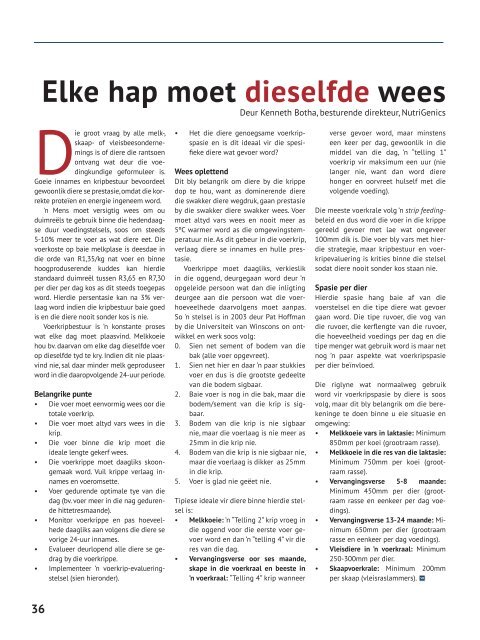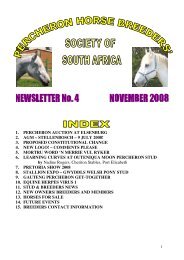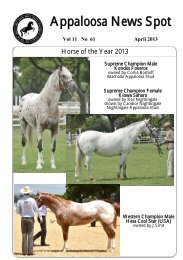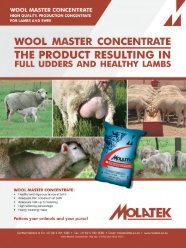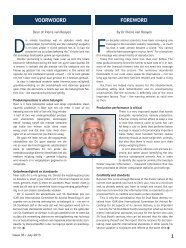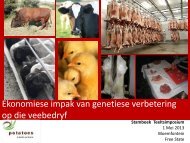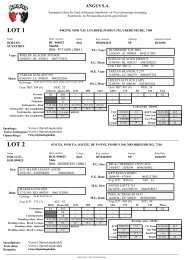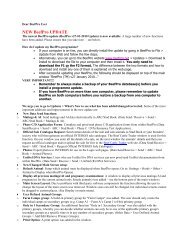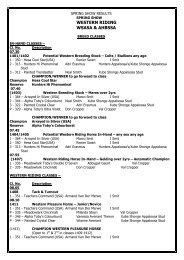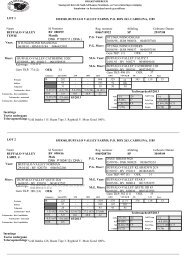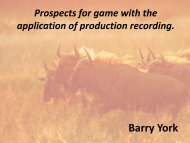Kliek hier vir bladsy 36-48 - SA Stamboek
Kliek hier vir bladsy 36-48 - SA Stamboek
Kliek hier vir bladsy 36-48 - SA Stamboek
You also want an ePaper? Increase the reach of your titles
YUMPU automatically turns print PDFs into web optimized ePapers that Google loves.
Elke hap moet dieselfde wees<br />
Deur Kenneth Botha, besturende direkteur, NutriGenics<br />
Die groot vraag by alle melk-,<br />
skaap- of vleisbeesondernemings<br />
is of diere die rantsoen<br />
ontvang wat deur die voedingkundige<br />
geformuleer is.<br />
Goeie innames en kripbestuur bevoordeel<br />
gewoonlik diere se prestasie, omdat die korrekte<br />
proteïen en energie ingeneem word.<br />
'n Mens moet versigtig wees om ou<br />
duimreëls te gebruik binne die hedendaagse<br />
duur voedingstelsels, soos om steeds<br />
5-10% meer te voer as wat diere eet. Die<br />
voerkoste op baie melkplase is deesdae in<br />
die orde van R1,35/kg nat voer en binne<br />
hoogproduserende kuddes kan <strong>hier</strong>die<br />
standaard duimreël tussen R3,65 en R7,30<br />
per dier per dag kos as dit steeds toegepas<br />
word. Hierdie persentasie kan na 3% verlaag<br />
word indien die kripbestuur baie goed<br />
is en die diere nooit sonder kos is nie.<br />
Voerkripbestuur is ’n konstante proses<br />
wat elke dag moet plaasvind. Melkkoeie<br />
hou bv. daarvan om elke dag dieselfde voer<br />
op dieselfde tyd te kry. Indien dit nie plaasvind<br />
nie, sal daar minder melk geproduseer<br />
word in die daaropvolgende 24-uur periode.<br />
Belangrike punte<br />
• Die voer moet eenvormig wees oor die<br />
totale voerkrip.<br />
• Die voer moet altyd vars wees in die<br />
krip.<br />
• Die voer binne die krip moet die<br />
ideale lengte gekerf wees.<br />
• Die voerkrippe moet daagliks skoongemaak<br />
word. Vuil krippe verlaag innames<br />
en voeromsette.<br />
• Voer gedurende optimale tye van die<br />
dag (bv. voer meer in die nag gedurende<br />
hittetresmaande).<br />
• Monitor voerkrippe en pas hoeveelhede<br />
daagliks aan volgens die diere se<br />
vorige 24-uur innames.<br />
• Evalueer deurlopend alle diere se gedrag<br />
by die voerkrippe.<br />
• Implementeer ’n voerkrip-evalueringstelsel<br />
(sien <strong>hier</strong>onder).<br />
• Het die diere genoegsame voerkripspasie<br />
en is dit ideaal <strong>vir</strong> die spesifieke<br />
diere wat gevoer word?<br />
Wees oplettend<br />
Dit bly belangrik om diere by die krippe<br />
dop te hou, want as dominerende diere<br />
die swakker diere wegdruk, gaan prestasie<br />
by die swakker diere swakker wees. Voer<br />
moet altyd vars wees en nooit meer as<br />
5ºC warmer word as die omgewingstemperatuur<br />
nie. As dit gebeur in die voerkrip,<br />
verlaag diere se innames en hulle prestasie.<br />
Voerkrippe moet daagliks, verkieslik<br />
in die oggend, deurgegaan word deur ’n<br />
opgeleide persoon wat dan die inligting<br />
deurgee aan die persoon wat die voerhoeveelhede<br />
daarvolgens moet aanpas.<br />
So 'n stelsel is in 2003 deur Pat Hoffman<br />
by die Universiteit van Winscons on ontwikkel<br />
en werk soos volg:<br />
0. Sien net sement of bodem van die<br />
bak (alle voer opgevreet).<br />
1. Sien net <strong>hier</strong> en daar ’n paar stukkies<br />
voer en dus is die grootste gedeelte<br />
van die bodem sigbaar.<br />
2. Baie voer is nog in die bak, maar die<br />
bodem/sement van die krip is sigbaar.<br />
3. Bodem van die krip is nie sigbaar<br />
nie, maar die voerlaag is nie meer as<br />
25mm in die krip nie.<br />
4. Bodem van die krip is nie sigbaar nie,<br />
maar die voerlaag is dikker as 25mm<br />
in die krip.<br />
5. Voer is glad nie geëet nie.<br />
Tipiese ideale <strong>vir</strong> diere binne <strong>hier</strong>die stelsel<br />
is:<br />
• Melkkoeie: ’n “Telling 2” krip vroeg in<br />
die oggend voor die eerste voer gevoer<br />
word en dan ’n “telling 4” <strong>vir</strong> die<br />
res van die dag.<br />
• Vervangingsverse oor ses maande,<br />
skape in die voerkraal en beeste in<br />
’n voerkraal: “Telling 4” krip wanneer<br />
verse gevoer word, maar minstens<br />
een keer per dag, gewoonlik in die<br />
middel van die dag, ’n “telling 1”<br />
voerkrip <strong>vir</strong> maksimum een uur (nie<br />
langer nie, want dan word diere<br />
honger en oorvreet hulself met die<br />
volgende voeding).<br />
Die meeste voerkrale volg ’n strip feedingbeleid<br />
en dus word die voer in die krippe<br />
gereeld gevoer met lae wat ongeveer<br />
100mm dik is. Die voer bly vars met <strong>hier</strong>die<br />
strategie, maar kripbestuur en voerkripevaluering<br />
is krities binne die stelsel<br />
sodat diere nooit sonder kos staan nie.<br />
Spasie per dier<br />
Hierdie spasie hang baie af van die<br />
voerstelsel en die tipe diere wat gevoer<br />
gaan word. Die tipe ruvoer, die vog van<br />
die ruvoer, die kerflengte van die ruvoer,<br />
die hoeveelheid voedings per dag en die<br />
tipe menger wat gebruik word is maar net<br />
nog ’n paar aspekte wat voerkripspasie<br />
per dier beïnvloed.<br />
Die riglyne wat normaalweg gebruik<br />
word <strong>vir</strong> voerkripspasie by diere is soos<br />
volg, maar dit bly belangrik om die berekeninge<br />
te doen binne u eie situasie en<br />
omgewing:<br />
• Melkkoeie vars in laktasie: Minimum<br />
850mm per koei (grootraam rasse).<br />
• Melkkoeie in die res van die laktasie:<br />
Minimum 750mm per koei (grootraam<br />
rasse).<br />
• Vervangingsverse 5-8 maande:<br />
Minimum 450mm per dier (grootraam<br />
rasse en eenkeer per dag voedings).<br />
• Vervangingsverse 13-24 maande: Minimum<br />
650mm per dier (grootraam<br />
rasse en eenkeer per dag voedings).<br />
• Vleisdiere in ’n voerkraal: Minimum<br />
250-300mm per dier.<br />
• Skaapvoerkrale: Minimum 200mm<br />
per skaap (vleisraslammers). SB<br />
<strong>36</strong>
Anaplasmose is ’n komplekse<br />
siekte wat elke jaar etlike<br />
miljoene rande se verliese in<br />
die Suid-Afrikaanse lewendehawebedryf<br />
veroorsaak. Maar<br />
is dit nodig dat ’n siekte wat suksesvol<br />
deur getroue inenting beheer kan word,<br />
soveel verliese veroorsaak?<br />
Verspreiding en voorkoms<br />
Anaplasmose is ’n bosluisoordraagbare<br />
siekte wat deur twee spesies van ’n mikro-organisme,<br />
Anaplasma marginale en<br />
Anaplasma centrale, veroorsaak word. Net<br />
Anaplasma marginale veroorsaak egter<br />
die sigbare siekte. Die mikro-organismes<br />
tas die rooibloedselle van besmette herkouers<br />
aan, wat dan deur die liggaam<br />
se immuunstelsel uit die bloedsirkulasie<br />
verwyder word en sodoende interne<br />
bloedverlies en erge bloedarmoede veroorsaak.<br />
Die oordrag van dié mikro-organismes<br />
vind hoofsaaklik deur middel van bloubosluise<br />
plaas, maar ander bosluisspesies<br />
kan ook ’n rol speel. Anders as by rooiwater,<br />
word die besmetting nie deur die<br />
eiers na die volgende generasie bosluise<br />
oorgedra nie. Bloedsuiende insekte kan<br />
ook die siekte oordra en dit kompliseer<br />
die beheer van die siekte verder. Enige<br />
instrumente wat met bloed besmet is,<br />
soos naalde, onthoorningsgereedskap en<br />
kastreermesse kan ook die siekte oordra.<br />
Anaplasmose het ’n hoër voorkoms in<br />
gebiede en tye wanneer ’n groot aantal<br />
bosluise en bloedsuiende vlieë waargeneem<br />
word. Omdat die broeifase (oftewel<br />
die tydperk van die oordrag van die organisme<br />
tot die siekte uitbreek) gemiddeld<br />
vier tot ses weke duur, word die siekte<br />
dikwels eers in die winter opgemerk nadat<br />
dit reeds in die herfs deur bosluise<br />
oorgedra is.<br />
Voorsorg is beter as nasorg<br />
In die geval van anaplasmose is alle diere<br />
wat weerstand teen die siekte het, ook<br />
draers van die siekte. Onder normale omstandighede<br />
toon dié diere glad nie siektetekens<br />
nie, maar hulle is wel bronne van<br />
BESTUUR / MANAGEMENT<br />
Voorkom verliese weens anaplasmose<br />
Deur Marike Brits<br />
infeksie <strong>vir</strong> vatbare diere. Alle volwasse<br />
diere wat nie vantevore met die siekte<br />
besmet geraak of teen die siekte ingeënt<br />
is nie, is vatbaar <strong>vir</strong> anaplasmose.<br />
Kalwers toon baie selde ernstige siektetekens<br />
na besmetting, aangesien hulle<br />
’n nie-spesifieke weerstand teen die siekte<br />
het tot op die ouderdom van nege tot<br />
twaalf maande. Weerstand neem egter af<br />
soos die dier ouer word. Indien kalwers<br />
dan voor hulle nege maande oud is besmet<br />
word, ontwikkel hulle weerstand<br />
teen die siekte sonder om enige siektetekens<br />
te toon.<br />
Vir die suksesvolle voorkoming van<br />
anaplasmose-oordrag is bosluisbeheer<br />
noodsaaklik. Verder word die inenting van<br />
kalwers tussen drie en nege maande oud<br />
met die anaplasmose-bloedentstof wat<br />
die A. centrale spesie bevat, aanbeveel<br />
waar daar wel op ’n jaarlikse basis baie<br />
verliese voorkom.<br />
’n Spesifieke plaasdiagnose van anaplasmose<br />
is baie moeilik omdat dit baie<br />
soos rooiwater lyk. Siektetekens word<br />
eers sigbaar vier tot ses weke na diere<br />
aan besmette bosluise blootgestel is,<br />
maar die parasiet begin reeds in die bloed<br />
vermenigvuldig vanaf oordrag. Die dier<br />
sal eers siektetekens begin toon wanneer<br />
’n hoë persentasie van die rooibloedselle<br />
wat aangetas is, reeds deur die dier se<br />
eie immuunstelsel uit die bloedsirkulasie<br />
verwyder is.<br />
Lusteloosheid, verlaagde eetlus gepaardgaande<br />
met ’n koorsreaksie en wit<br />
slymvliese (bloedarmoede) is van die<br />
vroegste tekens. Meer gevorderde siektetekens<br />
is geel slymvliese (geelsug),<br />
rumenstase, depressie, ’n verlies aan eetlus,<br />
swaar of versnelde asemhaling en<br />
hardlywigheid. By melkbeeste is een van<br />
die vroegste waarskuwings van die kliniese<br />
siekte gewoonlik ’n skielike daling<br />
in melkproduksie.<br />
Geel oogslymvliese word gesien in gevorderde<br />
gevalle van anaplasmose.<br />
Blitsige behandeling<br />
Die eerste siektetekens word eers waarneembaar<br />
wanneer meer as die helfte van<br />
die dier se rooibloedselle reeds aangetas<br />
is en die dier dus reeds erge bloedarmoede<br />
onder lede het. Dit is noodsaaklik dat<br />
’n veearts die diagnose bevestig sodra die<br />
eerste siektetekens waargeneem word.<br />
Die veearts sal ’n voorlopige diagnose<br />
maak op grond van siektetekens, maar<br />
anaplasmose as siekte-oorsaak kan slegs<br />
bevestig word deur die mikroskopiese ondersoek<br />
van ’n bloedsmeer.<br />
Vroeë waarneming van die eerste siektetekens<br />
en onmiddellike behandeling is<br />
dus ’n sleutelfaktor. Daar is twee produkte<br />
wat gebruik kan word <strong>vir</strong> die behandeling<br />
van anaplasmose. Die korrekte dosis<br />
tetrasiklien-antibiotikum is doeltreffend<br />
teen anaplasmose. ’n Middel wat<br />
imidokarb bevat kan ook gebruik word<br />
en is doeltreffend teen anaplasmose en<br />
rooiwater. Laasgenoemde word veral gebruik<br />
wanneer die diagnose nog nie bevestig<br />
is nie.<br />
Voor en na behandeling moet die dier<br />
baie rustig hanteer word, want hy kan<br />
vrek weens ’n geweldige suurstoftekort<br />
as gevolg van die bloedarmoede. Opvolg<br />
ondersteunende behandeling is dikwels<br />
nodig om die werking van die grootpens<br />
weer aan die gang te kry.<br />
Waar anaplasmose op ’n jaarlikse basis<br />
verliese veroorsaak, moet ’n siektevoorkomende<br />
plan in konsultasie met u kuddeveearts<br />
uitgewerk word. Inenting bly die<br />
hoeksteen <strong>vir</strong> doeltreffende voorkoming<br />
van vrektes weens anaplasmose. SB<br />
Issue 35 ▪ July 2013<br />
37
More than just skin deep<br />
By Richard York<br />
One of the most important selection criteria that<br />
needs to be considered in wildebeest, as well as<br />
other game, is the colour of the hair and skin. An<br />
antelope’s skin refers to the whole area that covers<br />
its body and which is covered in hair. It is also the<br />
biggest organ in its body and comprises approximately 7 to 8% of<br />
the animal’s live mass.<br />
The skin is the shield between the antelope’s body and the<br />
external en<strong>vir</strong>onment. Thus the efficient functioning of this organ<br />
is of vital importance when the animal has to adapt to the<br />
circumstances to which he is exposed. The condition of the hair<br />
is also a direct reflection of the condition of the animal, and it<br />
indicates whether its hormone balance and nutritional status are<br />
in a good state.<br />
Buffalo with their dark skins rest in the shade for most of the day in order to<br />
avoid sunlight. (Photograph by Richard York)<br />
A heat regulator<br />
Another special characteristic of the skin is that it is the most<br />
important heat regulator of the animal. Wildebeest are warmblooded,<br />
and the speed and efficiency with which several mechanisms<br />
are implemented to neutralise the stress caused by heat<br />
and cold, is also an indication of the animal’s adaptability.<br />
Heat is released in the body on a continuous basis due to physiological<br />
and metabolic processes. The body needs to get rid of<br />
heat continuously in order to prevent an excessive increase in<br />
body temperature. The animal gets rid of heat through the following<br />
methods:<br />
• Radiation, conduction and convection.<br />
• Vaporisation of water from the skin and respiratory passages.<br />
• Excretion of faeces and urine.<br />
Sunlight’s enormous influence<br />
Radiation from the sun is intense in tropical areas and consists of<br />
rays in three different wavelengths:<br />
• Long wavelength – infrared or heat rays.<br />
• Medium wavelength – colours of the rainbow for which the<br />
eyes are very sensitive.<br />
• Shortwave or ultraviolet rays – invisible to the naked eye.<br />
It was found that the colour and hair type of an antelope have<br />
a direct influence on the efficiency of the reflection of both the<br />
infrared and light rays.<br />
Professor Jan Bonsma compiled a test to determine the reflection<br />
ability of Afrikaner cattle with different skin colours. Cream,<br />
light yellow, golden, light red, red and dark red skin colours were<br />
used in the test. It was clear from the tests that the lighter the animal’s<br />
skin colour, the more efficient its ability to reflect sunlight.<br />
More studies by Bonsma in the Mussina district showed that<br />
the influence of sunlight on a black cow during an 8,5-hour day<br />
is enough to boil 13 litres of water. Except for the heat generated<br />
A herd of wildebeest in the sunlight. (Photograph by Tamlyn Smith)<br />
by metabolic energy, animals must also get rid of an enormous<br />
amount of sun energy to maintain thermal equilibrium in a tropical<br />
en<strong>vir</strong>onment. Therefore buffalo which have a dark skin colour,<br />
must spend many hours during the day in deep shade and will<br />
rather graze and wallow in mud holes late in the evening, at night<br />
or during the early of the morning.<br />
Luckily the shortwave ultraviolet rays that cause cancer are<br />
reflected effectively by yellow, brown and black skin colours. It is<br />
therefore clear that a pigmented, light-coloured skin is the ideal<br />
combination to protect an animal against high temperatures and<br />
intense radiation.<br />
Golden Breeders believes it is not a coincidence that these<br />
highly adaptable colour variations of blue wildebeest occur naturally<br />
under the free-roaming wildebeest of the Limpopo River<br />
catchment area. The vegetation of this area is described as semisweet<br />
bushveld – one step away from the Kalahari desert, and it<br />
is one of the hottest, driest areas in South Africa.<br />
Golden Breeders believes that the golden wildebeest is proof<br />
that we are spectators of the process of evolution. Golden wildebeest<br />
are well adapted to resist climate change in an increasingly<br />
warmer and drier South Africa.<br />
(Adapted from the Golden Wildebeest Manual compiled by Golden<br />
Breeders.) SB<br />
38
BESTUUR / MANAGEMENT<br />
Perspective on<br />
mineral supplements<br />
By Dr Jasper Coetzee, sheep nutrition and management specialist consultant<br />
Livestock breeders have to familiarise<br />
themselves thoroughly<br />
with mineral shortages and/or<br />
imbalances that may occur, as<br />
these can have a negative effect<br />
on the production, reproduction and<br />
health of grazing animals and the digestion<br />
of their feed. The cost of rectifying<br />
these problems is often negligent compared<br />
to the results achieved.<br />
Production and reproduction tempo, as<br />
well as the health of grazing sheep and<br />
cattle, are often adversely affected by the<br />
occurrence of marginal mineral shortages<br />
and/or imbalances, which have a significant<br />
impact on animal performance even<br />
before any clinical (visible) signs of shortages<br />
are observed.<br />
Production losses<br />
It is estimated that mineral and vitamin<br />
shortages can bring about a 2% loss in<br />
overall production in sheep (Court et al.,<br />
2010). One factor that is often ignored, is<br />
that the micro-organisms in the rumen of<br />
the ruminant require a series of minerals<br />
to ensure optimal and effective digestion<br />
of ingested grazing. These shortages can<br />
be the direct result of too low levels of<br />
minerals in the grazing, or of excessive intake<br />
of certain minerals known as antagonists.<br />
Animals’ mineral requirements are<br />
highly dependent on their physiological<br />
stage and productivity level, which means<br />
that, as the animal’s production and reproduction<br />
increase due to crossbreeding, selection<br />
progress and/or improved management<br />
practices, its mineral requirements<br />
will increase accordingly. Marginal mineral<br />
shortages in animals presenting a low production<br />
level, will increase even more as<br />
production and reproduction increase.<br />
The mineral and vitamin requirements<br />
of ruminants have been published in various<br />
text books and articles. These tables<br />
reflect the estimated minimum requirements<br />
(Lee et al., 2002) of an average animal<br />
under normal conditions, but do not<br />
take into account the differences between<br />
animals, grazing and the en<strong>vir</strong>onment. In<br />
other words, these tables serve only as a<br />
guideline.<br />
Feed scientists do estimates based on<br />
grazing, soil and water analyses, as well as<br />
tissue, blood and bone analyses of animals,<br />
to determine which minerals and at which<br />
levels should be supplemented via licks<br />
for animals on a specific farm, especially<br />
where animals are not performing according<br />
to their genetic potential.<br />
Monitoring<br />
Continued monitoring of the mineral status<br />
of a sheep and cattle herd, as well as<br />
the observation of typical symptoms of<br />
mineral shortages, is an essential part of<br />
a general management programme. Socalled<br />
dose response trials are often used<br />
as opposed to a control, in order to confirm<br />
a shortage and to determine a reaction to<br />
a supplement.<br />
When determining livestock’s mineral<br />
requirements, one should always consider<br />
the possibility of extreme climate conditions<br />
and the fact that animals’ needs increase<br />
as they move over great distances<br />
while searching for grazing. However, animals’<br />
mineral requirements become less<br />
important when they are exhibiting an energy<br />
and/or protein shortage.<br />
It therefore appears to be uneconomical<br />
to supply mineral supplements to grazing<br />
animals if they are experiencing an energy<br />
and/or protein shortage. On the other<br />
hand, if energy and protein are sufficient, a<br />
high level of minerals is required to maintain<br />
a high growth rate. Mineral shortages<br />
and/or imbalances can be rectified by supplementing<br />
it in licks specially formulated<br />
to supplement shortages in a natural manner.<br />
It is also the most economical method<br />
to supplement mineral shortages.<br />
Beware of too much<br />
Grazing animals obtain their minerals by<br />
ingesting grazing, water, soil and licks.<br />
Often too high levels of certain minerals,<br />
so-called antagonists (such as calcium,<br />
iron, sulphur, molybdenum, sodium and<br />
potassium), occur in one or more of these<br />
sources. This has a negative effect on the<br />
absorption of other minerals and leads to<br />
mineral shortages.<br />
For example, a too high intake of calcium<br />
from lime-rich drinking water can<br />
lead to a shortage of manganese, zinc, selenium,<br />
copper, cobalt, iodine, phosphorus,<br />
magnesium and vitamin A. It is therefore<br />
recommended that part (30 to 50%) of<br />
the trace elements in a lick is supplied in<br />
organic format (Short, 2006).<br />
Supplementation of minerals, trace<br />
elements and vitamins for grazing animals<br />
cannot be done only through licks – not<br />
all animals eat licks or take in sufficient<br />
amounts of lick. Up to 18% of the sheep<br />
in a herd don’t ingest any lick (Lobato<br />
et al., 1980) and up to 30% don’t ingest<br />
sufficient amounts of lick (Pinchak, 2000).<br />
Approximately 17 to 38% of cattle in three<br />
studies ingested no lick, while up to 30%<br />
ingested only small amounts of the lick<br />
(Bowman & Sowell, 1997).<br />
This lends credibility to the view that,<br />
during strategic times of the year (prior<br />
to the breeding seasons, before the lambing<br />
and calving season, at weaning and<br />
upon introduction to a feedlot), an additional<br />
trace mineral supplement must be<br />
given via a dosage or injection of trace<br />
elements.<br />
Macro-minerals can only be supplemented<br />
via licks and producers should<br />
aim for their animals to ingest the recommended<br />
amount of lick. Include the correct<br />
level in intake-inhibitors in the licks<br />
and practise correct lick trough management<br />
(e.g. placement of lick troughs).<br />
For more information, phone the author<br />
on 076 846 8800 or email<br />
jasperco@iafrica.co.za. SB<br />
Issue 35 ▪ July 2013<br />
39
PRODUCTION RECORDS<br />
Logix Game: A structured<br />
recording system for wildlife<br />
ranching in South Africa<br />
By Dr Japie van der Westhuizen, South African Stud Book and Animal Improvement Association<br />
South Africa has a rich history of<br />
animal recording. The focus has<br />
mainly been on the recording<br />
of so-called farm animals (livestock)<br />
and was initially aimed<br />
at the keeping of stud books for different<br />
breeds. The South African Stud Book<br />
and Animal Improvement Association was<br />
founded by a group of stud breeders in<br />
1905 for this purpose.<br />
From the onset the independence of<br />
the individual breeders’ societies or groups<br />
(in terms of their respective constitutions)<br />
was recognised, but <strong>SA</strong> Stud Book is being<br />
tasked to oversee the recording of ownership,<br />
keepers and particulars of the animals<br />
of their members and to also see to it that<br />
the particular constitutions are being adhered<br />
to. As a private, non-profit association,<br />
<strong>SA</strong> Stud Book belongs to its members,<br />
the breeders’ societies (or groups). Effectively<br />
the members have direct decision<br />
powers in the services, budget and fees.<br />
<strong>SA</strong> Stud Book is registered as a registering<br />
authority under the Animal Improvement<br />
Act (Act 62 of 1998). A total of 63 registered<br />
animal breeders’ societies are members of<br />
<strong>SA</strong> Stud Book, plus an additional 25 direct<br />
entry breeds (breeds without a society), all<br />
making use of the services rendered by<br />
<strong>SA</strong> Stud Book.<br />
Why record?<br />
Not only due to the commercialisation of<br />
wildlife, but also for many other important<br />
reasons, the recording of individual animals,<br />
ownership (and locality), pedigree (if<br />
known), physical characteristics, measurements<br />
or scored traits, animal events (such<br />
as births, time and locality of handling,<br />
blood, tissue or semen samples, DNA evaluation,<br />
measurements and weights, transfers<br />
Figure 1: Pathways for data submission, uptake, calculation and reporting for wildlife.<br />
of ownerships, matings, etc.) and other species-specific<br />
needs, are all main considerations<br />
for any commercial enterprise. This is<br />
therefore as important for game management<br />
as for breeding or farming with any<br />
other farm animal.<br />
The mere recording of lineage (parentage<br />
linked to origin) and ownership (also locality)<br />
have many advantages, namely:<br />
• Calculation of species (breed) structures<br />
where prominence and influence<br />
of breeders, lines and origins can be<br />
quantified.<br />
• General demographics can be quantified.<br />
• Bottlenecks in the breeding structure<br />
can be identified and addressed.<br />
• Average and specific genetic relationships<br />
can be calculated and used for<br />
inbreeding calculations and the prevention<br />
of matings that can lead to<br />
inbreeding depression.<br />
The real advantages, however, are to extend<br />
recording functions to include additional<br />
information of economic value that<br />
will be beneficial to wildlife ranchers, can<br />
contribute to identifying superior breeding<br />
stock and can assist in research and a wider<br />
understanding of the particular species.<br />
For this purpose recordings on Logix, a centralised<br />
generally accessible database, is<br />
essential as each animal’s particulars with<br />
regards to the following will be known and<br />
can be used in a wider context of actions<br />
related to profit:<br />
• Any event of significance in the animal’s<br />
life, such as:<br />
Issue 35 ▪ July 2013<br />
43
PRODUCTION RECORDS<br />
Figure 2: Example of inbreeding reporting in a herd, assisting individual or groups of breeders in making breeding decisions.<br />
º º Mating particulars.<br />
º º Births/giving birth.<br />
º º Treatment of any kind.<br />
º º Change of ownership or locality.<br />
º º Deaths / termination.<br />
• Any laboratory results.<br />
• Collection of biological samples of the<br />
animal, by whom and location stored<br />
(such as hair, body tissue, blood or extracted<br />
DNA at a bio-bank or laboratory).<br />
• Any measurements or observations,<br />
like:<br />
º º Weight.<br />
º º Body measurements, especially<br />
linked to economic value such as<br />
horn length and circumference or<br />
other properties.<br />
º º Descriptions (like colour, constitution,<br />
deviations).<br />
º º Condition (e.g. teeth, general health,<br />
etc.).<br />
• Visual depiction, such as digital photographs<br />
and video clips.<br />
The extension of recordings will have an<br />
immediate effect on:<br />
• The viability of directed breeding.<br />
• Accurate assessments of phenotypic<br />
properties of the whole population.<br />
• Linkages and quantification of traits<br />
and properties to specific lines or<br />
progeny groups.<br />
• Quantifying and listing of general<br />
health and disease occurrence and<br />
treatment.<br />
• Research and the utilisation of the genetic<br />
base for traits and properties of<br />
economic importance.<br />
• Linking differences among animals in<br />
the population with variation on the<br />
DNA (molecular) level and development<br />
of tools useful for wildlife breeding<br />
and maintaining biodiversity.<br />
• Extension of reports useful to breeders,<br />
multipliers, auctioneers, buyers, researchers,<br />
organised wildlife organisations<br />
and others.<br />
• Developing and implementing a system<br />
where the genetic merit for traits<br />
of economic importance of each animal<br />
can be calculated. These processes<br />
include the phenotypic (measured)<br />
values in combination with molecular<br />
(genomic) information.<br />
• Developing and implementation of<br />
sensible selection and breeding plans<br />
for more rapid achievement of breeding<br />
goals, including colour variants,<br />
fitness (fertility and survivability) and<br />
other traits of economic importance<br />
(such as horn properties or other body<br />
characteristics).<br />
Practical considerations<br />
It all starts with the unique identification<br />
of each animal within the population (species).<br />
The seed stock (stud) sector in the<br />
livestock industry has developed a comprehensive<br />
system where each breeder has a<br />
unique herd designation mark (HDM). It assists<br />
in unique identification of each animal<br />
based on the herd it was born in.<br />
A typical unique identification will<br />
then be:<br />
Species/Breed [3] + (Country [3]) +<br />
Sex [1] + HDM [4] + Birth Year [4] +<br />
Sequence within birth year [4].<br />
Physically the identification the animal<br />
has to carry only consists of the HDM +<br />
birth year (only two characters) and a sequence<br />
number. The unique identification<br />
is furthermore logically linked to any other<br />
identification such as RFID/microchip, common<br />
name, tag or any other means of identification.<br />
Once this has been established, the rest<br />
can follow. In the first place a proper inventory<br />
needs to be established and the data<br />
base populated with all relevant information.<br />
Figure 1 depicts the pathways of data<br />
submission, uptake, calculations and reporting:<br />
Each breeder (owner) has a choice to use<br />
the means best suited to his needs when<br />
information is submitted. The method of<br />
choice usually is direct entries via the Internet<br />
or by making use of PC-based software.<br />
The power of knowledge<br />
The real value will only be derived once<br />
the majority of the animals in a population<br />
are being recorded. The Logix system<br />
provides for interactive reporting based on<br />
user-defined searches, designs and even<br />
the possibility of benchmarking. Even in the<br />
case of sales catalogues, the information is<br />
validated against the recorded information<br />
on the system.<br />
Figure 2 is one example of typical<br />
reports currently available to livestock<br />
breeders that could also have relevance<br />
(with a few modifications) to wildlife.<br />
All activities in one system<br />
The key to integration is ease of use with<br />
accessibility also as a top priority. The game<br />
farmer is occupied in a number of activities.<br />
Most of these centre on the well-being,<br />
soundness and desirability of his product.<br />
Any system should therefore be aimed at<br />
assisting him in these goals.<br />
Logix, the system offered by <strong>SA</strong> Stud<br />
Book, has been successful in offering a complete<br />
animal recording and improvement<br />
system for livestock farmers (and a few others<br />
such as Alpacas and three dog<br />
(Continued on p.47)<br />
Issue 35 ▪ July 2013<br />
45
PRODUCTION RECORDS<br />
(Continued from p.45)<br />
breeds) where reproduction, production,<br />
efficiency, health, nutritional needs, product<br />
quality, functional and culling properties,<br />
references to DNA (and other) laboratories<br />
and bio-banks, linear scores and measured<br />
type traits, physical description, photos,<br />
genetic merit (breeding values), inbreeding<br />
coefficients, show (and other competitions)<br />
awards and other characteristics and traits<br />
are recorded.<br />
The next very logical step is therefore<br />
to use this very well-established<br />
and tested system for the wildlife<br />
industry. The same principles of coownership<br />
and needs-driven future<br />
developments also apply, making<br />
the system flexible but still truly<br />
based on all the scientific principles<br />
of animal improvement.<br />
In all cases the individual breeder or group<br />
has an own choice of service providers such<br />
as DNA laboratories, bio-banks, diagnostic<br />
services, animal nutritionists, veterinarians,<br />
technical advisors or any other service<br />
providers. The owner or manager, however,<br />
has a single point of entry and reports are<br />
also taking all the different aspects into<br />
consideration, giving a holistic view to<br />
assist in making the correct management<br />
decisions.<br />
One very big advantage of using a centralised<br />
system is that duplication will be<br />
avoided for tracing biological samples in<br />
any bio-bank. These samples only need to<br />
be taken once, with the possibility of exchange<br />
of extracted DNA amongst the roleplayers.<br />
Any of the relevant institutions, as<br />
well as other service providers, will be able<br />
to access relevant information (with the<br />
consent of the owner) via the web.<br />
Staying on top of your game<br />
Game farmers have access to the latest<br />
technologies. The choice of using some<br />
of them should be governed by a vision of<br />
maintaining an edge to ensure sustainable<br />
profit. By simply combining current activities<br />
and pooling information, whilst at the<br />
same time becoming part of a wider network<br />
of scientific knowledge and innovation,<br />
this goal can be achieved.<br />
Logix Game now offers game farmers<br />
access to the latest in animal recording<br />
and improvement. Not only in terms<br />
of desirable genetic changes, but also in<br />
management decisions that maximise the<br />
possibilities for success in game ranching<br />
and breeding.<br />
For more information, contact Japie van<br />
der Westhuizen on 082 331 9923 or<br />
japie@studbook.co.za.<br />
(Adapted from an article published in the<br />
WR<strong>SA</strong> publication, Wildlife Ranching, Autumn<br />
2013.) SB<br />
Issue 35 ▪ July 2013<br />
47
KEN ONS MENSE<br />
Sumari Taljaard<br />
Ek is in Clocolan in die Oos-Vrystaat gebore en het aan die Hoër<br />
Landbouskool Kroonstad gematrikuleer, waarna ek by die Universiteit<br />
van die Vrystaat B-Ed studeer het. Na my studies het ek by<br />
die Lady Grey Kunste-akademie as onderwyser begin werk. Ek is<br />
in 2001 met Christo Taljaard getroud en het daarna op Dordrecht<br />
begin skoolhou, waar Christo in die Sterkstroom-distrik geboer<br />
het. Ons eerste seun, Nathan, is in 2003 gebore. Ons het na<br />
Bloemfontein verhuis, waar ek as persoonlike assistent gewerk<br />
het. Ek het ook in dieselfde jaar ’n diplomakursus in menslike<br />
hulpbronne en skakelwese deur Unisa voltooi. In 2009 is Christopher<br />
gebore.<br />
Ek het in Januarie 2010 by <strong>SA</strong> <strong>Stamboek</strong> begin werk in die registrasie-afdeling,<br />
waar ek perde-registrasies hanteer het. Ek het<br />
op 1 Junie vanjaar oorgeskuif na die sekretariaat, waar ek tans sekretaresse<br />
van die Appaloosa- en Percheron Perdegenootskappe<br />
is. Ek is opgewonde oor <strong>hier</strong>die nuwe hoofstuk wat voorlê.<br />
Liza Verwey<br />
Ek is gebore in Kimberley en ’n jaar daarna het my ouers besluit<br />
dat dit nou tyd is om plaas toe te trek. Ek het grootgeword op ’n<br />
pragtige plaas in die Christiana-distrik, waar ons met kommersiële<br />
Beefmasters boer. Ek het in Christiana by die Gekombineerde<br />
Skool Christiana gematrikuleer. In 2007 het ek die dorpie en<br />
plaas verlaat, en Bloemfontein toe getrek om webwerf-ontwikkeling<br />
by CTU Kollege te studeer.<br />
In 2009 is ek aangestel as webadministrateur by <strong>SA</strong> <strong>Stamboek</strong>.<br />
Ek is al vier jaar in dié organisasie se diens. Ek werk elke<br />
dag met die vriendelikste mense in ’n wonderlike bedryf. Ek is<br />
steeds mal oor die plaaslewe, en my werk <strong>hier</strong> is <strong>vir</strong> my amper<br />
soos ’n stukkie plaas in die stad met al die mooi foto’s wat ek<br />
elke dag van telers af ontvang om op die webwerwe te plaas.<br />
Philna Hattingh<br />
Ek is op 3 Desember 1986 in Kathu gebore. Dit was van ’n baie<br />
jong ouderdom al af <strong>vir</strong> my duidelik dat ek ’n groot liefde het<br />
<strong>vir</strong> die natuur en die skoonheid daarvan. Ek het in 2005 gematrikuleer<br />
en het ’n BA-graad in menslike bewegingskunde<br />
verwerf. Ek wou baie graag my kennis verder verbreed in die<br />
rekreasiegebied en het in 2010 by die Aasvoëlberg Buitelugsentrum<br />
se span aangesluit. Daar het ek ongelooflike mensekennis<br />
opgedoen.<br />
Zastron was my tuiste <strong>vir</strong> drie jaar, maar 'n mens kan egter<br />
net <strong>vir</strong> so lank tussen die berge in die koue speel. Ek het besluit<br />
dat ’n skuif na <strong>SA</strong> <strong>Stamboek</strong> se registrasie-afdeling die<br />
regte een sal wees <strong>vir</strong> my. Ek hoop om <strong>hier</strong> my kennis verder<br />
te verbreed en saam met die span mense ’n lang pad te stap. SB<br />
<strong>48</strong>


